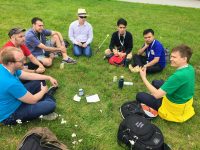We spoke to Karbi community elder Mr. D.S. Teron who has been self-sponsoring research on the Karbi language and the culture.The audio recording and additional research were made by Subhashish Panigrahi and all the content and metadata are released under multiple Creative Commons licenses which requires proper attribution though the access and use/reuse are allowed based on the license type. Check individual file description for the licenses.
Karbi listen (Arleng or Mikir) language is spoken by 420,000 speakers spread across North-East Indian states of Assam, Arunachal Pradesh, Meghalaya and Nagaland and is one of the vulnerable languages of South Asia as identified by UNESCO. Karbi is grouped under the “Mikir languages” which itself is part of the 50-odd-languages that are known as the Kuki-Chin language grouplisten or simply known as Kukish languages. The last known census was in 2001 and the number of speakers might have increased by now but there are only a handful of people that are working for reviving the language. D.S. Teron is one of them—he is a veteran and is a full time self-sponsored researcher based in the Karbi Anglong district of Assam. He belongs to the Kur clan of the Karbi people which is one of the five Karbi clans—Terang, Teron, Enghee. Ingti and Timung. We had a candid conversation with Mr. Teron to learn about the folklore, folk songs, local festivals and traditional games from him. The Karbi elders have been historically great storytellers, be it while recounting the past of deceased family members through Mosera Kihir, or the wailing songs of Kecharhe remembering the dead.
Audio notes
Full audio
The entire conversation can be listened above you can also listen to each topic in the next segment.
- Licensing, interviewee’s name: 00:00 – 01:48 (MM:SS format)
- Meaning of Karbi and the Karbi people: 01:48 – 03:27
- Description of interviewee’s birthplace: 03:27 – 04:18
- Traditional games for the kids: 04:18 – 08:52
- Linguistic details of Karbi language: 08:52 – 15:09
- Storytelling of the Karbi people: 15:09 – 27:21
- Folk song: 27:21 – 31:03
- Local fairs/festivals: 31:03 – 42:30
- Daily activities of the interviewee: 42:30 – 52:37
1. Pronunciation of interviewee’s nameIn this interview, Mr. Teron shares how his name is pronounced in Karbi and shares some details about how the family name is given based on local traditions. (Download audio)
2. Meaning of the word “Karbi” and the Karbi people
|
Metadata
| Language details | Recording details | ||
| Language | Karbi | Recording content | Narration of a folklore, a folk song, a local festival, traditional games, Meaning of “Karbi”, speaker’s daily activities |
| Dialect | N/A | Recording location | Remote, Speaker at Karbi Anglong district, Assam, India |
| Alternate name(s) | Mikir | Recording date | Sunday, May 21, 2017 at 8:55 AM |
| SIL Code | mjw | Recordist(s) | Subhashish Panigrahi |
| Current state | Living, endangered | Hardware | Zoom H1 |
| Language group | Tibeto-Burman languages | Software | Audacity |
| Possible influences | Assamese, Naga | #files | 10 |
| Open Language Archives Community (OLAC) | here | File format(s) | wav, flac |
| Swadesh word list | here | Bit rate | 16 bit PCM |
| Ethnologue | here | Total audio length (HH:MM:SS) | 00:53:37 |
| SIL International | here | Copyright | CC-BY-SA 4.0 |
| Wikipedia | here | Video | Not recorded |
| Wikipedia in respective language | N/A | Image | Not recorded |
| Scholarly citations on Google Scholar | here | ||
| Internet Archive resources | here | ||
| Speaker details | |||
| Speaker Gender | Male | ||
| Speaker Age | 50–60 | ||
| Speaker Origin | Karbi Anglong district, Assam, India | ||
| Speaker’s Name | D.S. Teron | ||
| Speaker’s Pictures | N/A | ||
Readings
- Moseley, Christopher (ed.). 2010. Atlas of the World’s Languages in Danger, 3rd edn. Paris, UNESCO Publishing. Online version: http://www.unesco.org/culture/en/endangeredlanguages/atlas
- René Kolkman, Stuart Blackburn. “Tribal Architecture in Northeast India“. BRILL, 2014. ISBN 9004263926, 9789004263925
- “A grammar of Karbi” . Konnerth, Linda (2014)
- “South Asia and the Middle East” (283-348) . George van Driem (2007) , Christopher Moseley · London & New York: Routledge
- C. M. (2017) Endangered Languages Project – Karbi. Retrieved October 16, 2017, from http://www.endangeredlanguages.com/lang/mjw
- Ager, Simon. (2017) Karbi language, pronunciation and alphabet. Retrieved October 16, 2017, from https://www.omniglot.com/writing/karbi.htm
- “An Introduction To The Karibi Language“. Shodhganga
- Anna Konnerth, Linda. “A Grammar Of Karbi“. Department of Linguistics, Graduate School of the University of Oregon, March 2014
- Serdihun Beypi and Sivasish Biswas. “Language, Culture, and Translation of the Karbi: A Brief Study“. International Journal of Social Science and Humanity, Vol. 2, No. 6, November 2012
Citations to this article:
- Subhashish Panigrahi, Karbi Elder D.S. Teron Shares Folklore, Folk Songs, Games And Festivals In Karbi Language, OpenSpeaks, O Foundation, 26 August 2019




